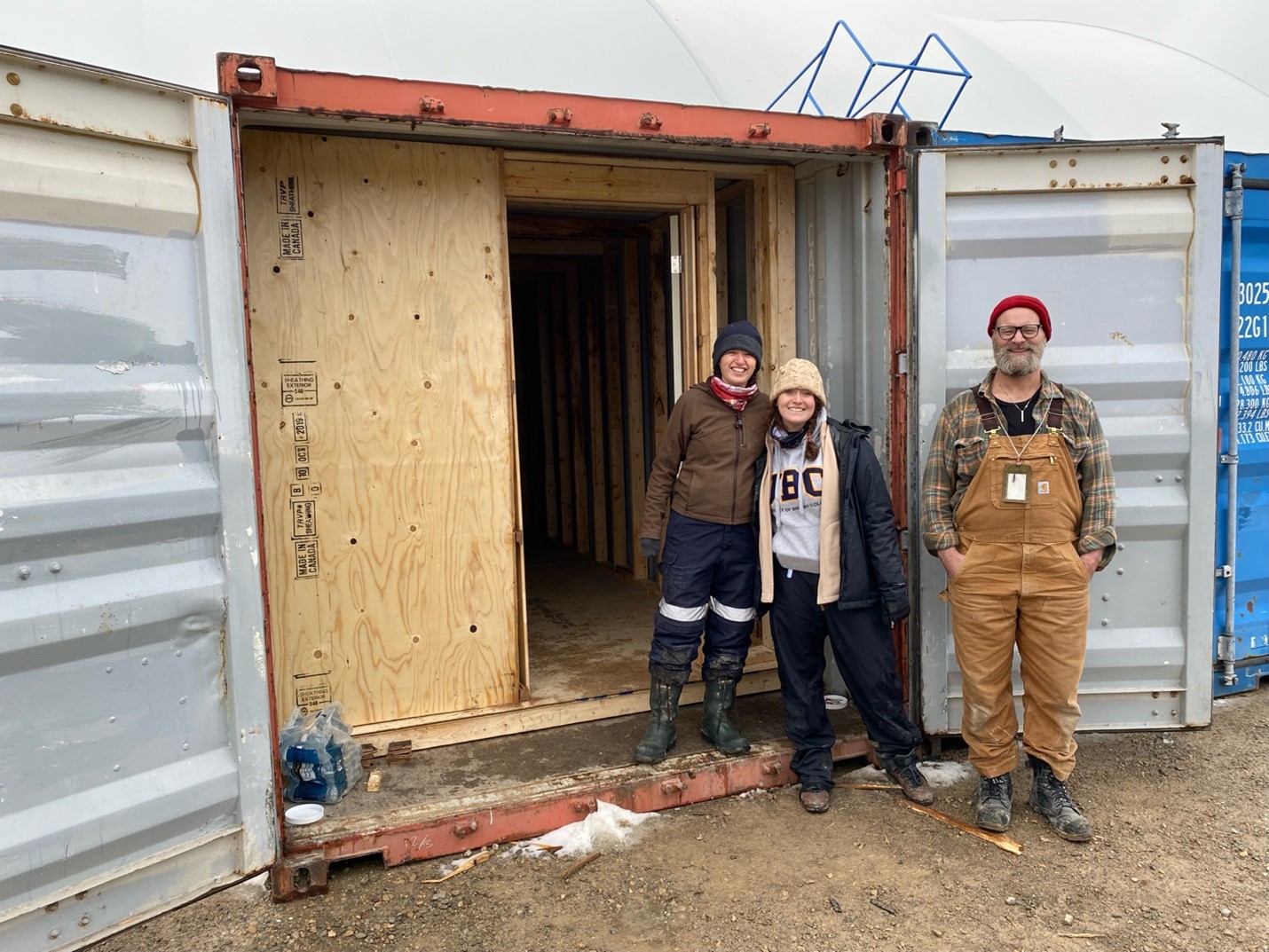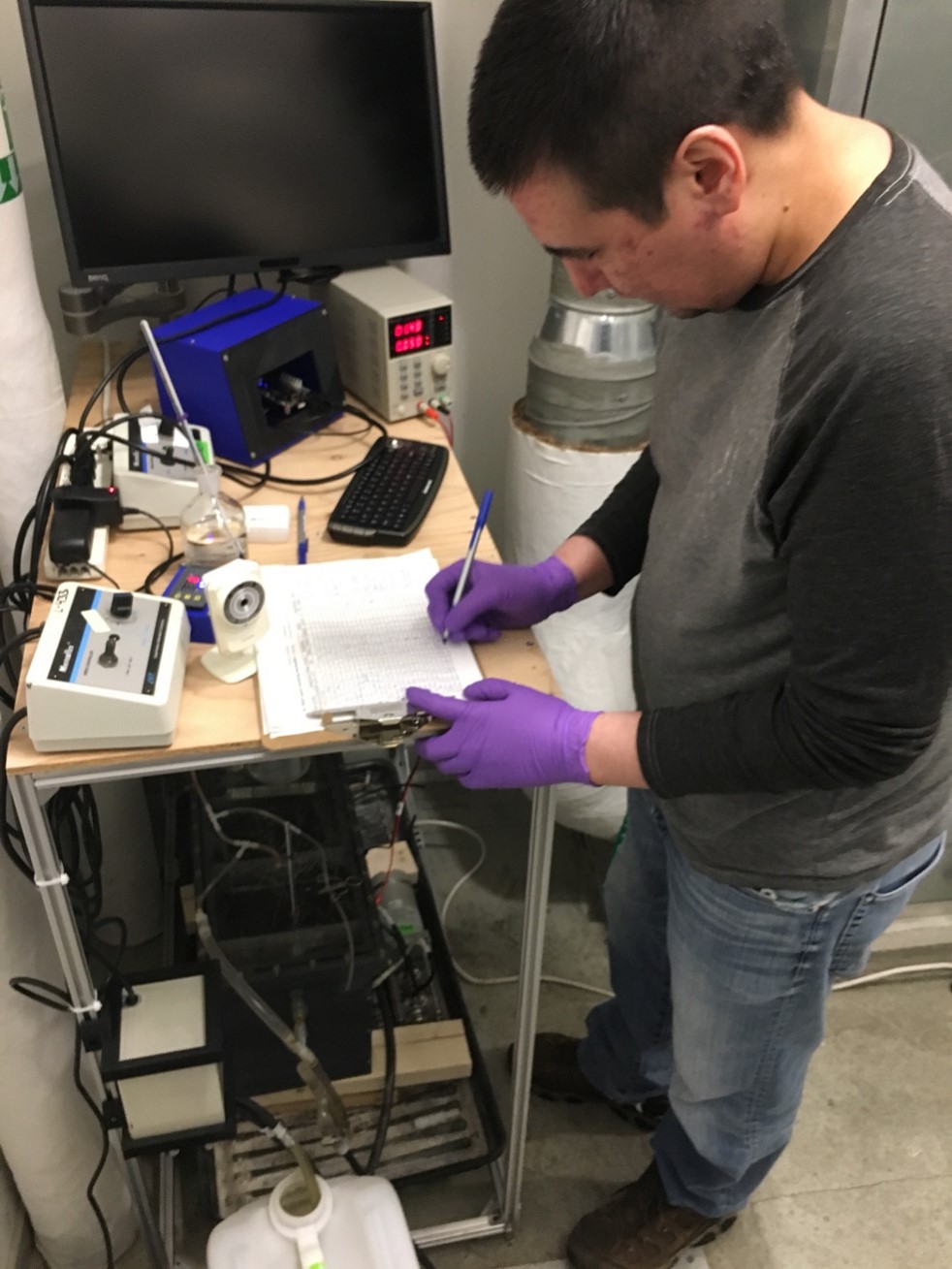POLAR's clean energy projects
Testing and demonstrating a small wind turbine in the Arctic
POLAR's clean energy team has been collaborating with National Research Council (NRC) and Natural Resources Canada (NRCan) to test and demonstrate a small 6kW off-grid wind turbine at CHARS. The Scottish-built SD6 turbine has undergone an independent assessment at NRC's Ottawa facility that will allow it to operate in Canada. It will be installed at CHARS next summer.
POLAR has also modified a sea can to house the inverters and batteries and is in the process of designing another for the generator. The generator will be housed in a sea can equipped with solar panels, becoming POLAR's first truly integrated microgrid and supplying off-grid power to the sprung shelter used for storing equipment.

Preparing to install a small wind turbine at CHARS, a POLAR technical team frames and insulates a sea can that will house the system electronics. L-R Rachel Mandel, Clean Energy Engineer; Nika Martinussen, Co-op student; Scott Johnson, Operations Manager.
Biofuels from food waste
Also with NRC, POLAR is looking at the potential to produce biofuels from the food waste generated in Cambridge Bay. POLAR's clean energy staff have been visiting businesses in the community to collect food waste, which is then shipped to NRC's laboratories in Ontario.
While assessing the potential of generating biofuel with the waste collected, NRC is also adapting a 6kW generator to operate on both diesel and methane. If the food waste proves to have enough energy potential, POLAR hopes to begin producing and testing biofuels at CHARS in summer 2023. The dual-fuel generator will also be shipped to CHARS and incorporated into the wind project as a backup energy source, operating partly from our own biofuels.
BeAST: Producing energy from human waste
Over the last three years, POLAR has been working with NRC to test the Bioelectrical Anaerobic Sewage Treatment System (BeAST). The BeAST uses anaerobic biodigestion to treat sewage so that the effluent going into the sewage lagoon is cleaner.
The anaerobic process produces heat and biomethane that can be used in district heating systems or for biofuels. This technology has the potential to significantly reduce the human environmental footprint in remote communities. Testing wrapped up early in 2022 and was very successful. POLAR and NRC plan to test a larger reactor at CHARS in 2023.

POLAR clean energy technician Jason Etuangat monitoring the BeAST waste-to-energy reactor installed at CHARS campus for testing
ARENA: Developing energy champions for remote communities
The Arctic Remote Energy Network Academy (ARENA), is a initiative of the Arctic Council that gives energy champions from remote communities across the circumpolar Arctic the skills, knowledge, and mentorship needed to develop local clean energy projects. POLAR is leading Canada's contribution to the technical aspects of this project, working with Crown-Indigenous and Northern Affairs (CIRNAC) and Gwich'in Council International.
ARENA focuses on community energy development by offering classroom and experiential learning: visiting projects and learning best practices. This year's participants are from Alaska, Greenland, Finland, and Canada. So far, participants have completed programs in Alaska and Iceland. One highlight includes a visit to the Arctic community of Kotzebue in Alaska, where the wind and storage projects have significantly reduced diesel dependence.
In Iceland, the group focused on geothermal and hydro energy and the economic and cultural impact of inexpensive renewable energy. The Canadian program was originally planned for May 2022 at CHARS, but the Arctic Council is on hold due to the Russian invasion of the Ukraine. Instead, the program will take place in the Yukon in January 2023.
Other Projects
A Community Energy Plan for Cambridge Bay
POLAR is supporting the development of a Community Energy Plan for Cambridge Bay, thanks to funding from CIRNAC Northern Reach. This funding supports the efforts of the Government of Nunavut, Kitikmeot Corporation, the Hamlet of Cambridge Bay, Nunasi Group and Aurora Energy. A Community Energy Plan is a prerequisite for support to future renewable energy projects. In October, POLAR presented a draft of the plan to a well-attended community engagement session in Cambridge Bay. The plan received extensive feedback.
Clean power for a community freezer
Community freezers are often a vital part of food security in northern communities, but large, walk-in freezers are expensive to buy and operate. The Ekaluktutiak Hunters and Trappers Organization (EHTO) in Cambridge Bay wishes to obtain a community freezer, and host it in one of their main buildings. They would like to use renewable energy for heat and electricity in these buildings. POLAR is assessing the EHTO buildings to establish whether solar power or a small wind turbine could be feasible. POLAR has two refrigerated sea cans that could be converted into freezers, and is working with NRC to determine whether they could be fully powered by solar energy in summer and operate without power over the fall and winter.
Green hydrogen in the Arctic
POLAR treats its wastewater with a reverse osmosis system, a filter that forces water through a membrane that traps contaminants. This system produces a large amount clean water, but this is being trucked to the sewage lagoon for disposal along with untreated wastewater from the community. It may be possible to convert this clean wastewater into hydrogen to power energy fuel cells, and to store energy. This could be an economical way of producing green fuel in the Arctic, if the process can be supported by POLAR's renewables microgrid project. POLAR, ATCO and NRC are exploring a potential collaboration that would allow NRC to assess the potential of the wastewater for making hydrogen, and develop a pilot project for hydrogen production at CHARS.
Polar Knowledge Canada
For media inquiries, contact:
communications@polar-polaire.gc.ca